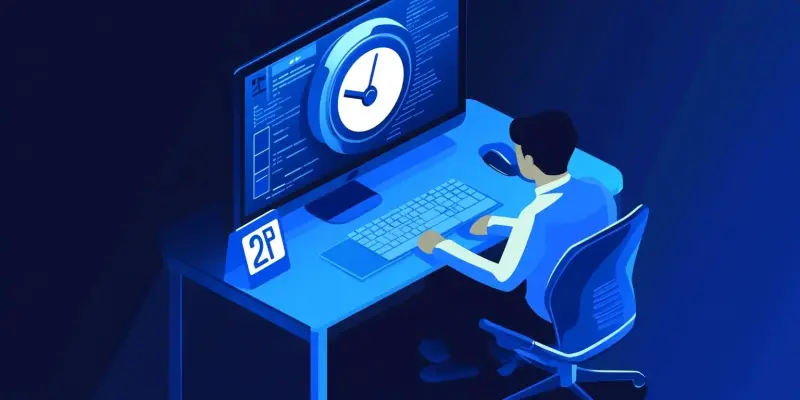In a recent wave of sophisticated phishing attacks, cybercriminals have been leveraging fake timesheet report emails and the Tycoon 2FA phishing kit to deceive users into surrendering their sensitive credentials. This cunning strategy exploits legitimate-looking emails to outwit regular security protocols and bypass Multi-Factor Authentication (MFA). Given that MFA is often considered a robust security feature, these advancements in phishing techniques highlight an urgent need for heightened vigilance and proactive security measures.
Exploiting the Trust: From Timesheet Emails to Pinterest Links
Deceptive Emails and Social Engineering
The phishing attack starts with a seemingly innocuous email titled “Timesheet Report,” luring the unsuspecting recipient with urgency and authenticity. The email contains a “View Timesheet” button, which redirects the user to a Pinterest link, cleverly exploiting Pinterest’s reputable image to lower suspicions. This initial step leverages social engineering principles by mimicking familiar and trusted business processes, thus increasing the likelihood of user engagement with the fraudulent link.
Upon clicking the link, the user is taken to a page exhibiting the Microsoft logo alongside a “Visit” button, further folding layers of legitimacy into the scam. The redirection to Pinterest initially distracts the user from questioning the legitimacy of the email, making the fraudulent activity seem inconspicuous. The intention here is clear: by manipulating the user’s trust in established platforms like Pinterest and Microsoft, the attackers aim to lead them into a trap crafted to harvest their credentials.
Cloudflare CAPTCHA to Capture Trust
As the user navigates these well-disguised stages, they encounter a Cloudflare CAPTCHA challenge meant to weed out automated bots while increasing the perceived security of the interaction. This step plays a critical role in reinforcing the user’s trust as the need to pass a CAPTCHA is often associated with genuine security measures. Once this hurdle is cleared, the user is redirected to a fake Microsoft login page, an almost perfect imitation designed to capture the unsuspecting victim’s credentials.
The decision to use a CAPTCHA, a common security feature, as part of this phishing strategy exemplifies the attacker’s understanding of user behavior and trust. By embedding such a realistic layer within the phishing sequence, they effectively mask their malicious intent and make it substantially harder for the user to recognize the deceit until it’s too late. This evolution in phishing tactics underscores the need for continuous education and awareness to identify subtle signs of fraud.
Tycoon 2FA Phishing Kit: A New Era of PhaaS
The Advancements of Tycoon 2FA
First identified in August 2023, the Tycoon 2FA phishing kit epitomizes the advancements in Phishing-as-a-Service (PhaaS). This platform is intricately designed to bypass the otherwise robust Multi-Factor Authentication systems by intercepting session cookies from Microsoft 365 or Gmail accounts. The Tycoon 2FA kit utilizes heavily obfuscated JavaScript and HTML code, a tactic designed to evade detection by conventional security systems, presenting a significant challenge for cybersecurity efforts.
Additionally, the kit employs advanced traffic filtering techniques, meticulously blocking developer tools and penetration-testing scripts to stave off analysis and inspections. Anti-inspection measures, amongst others, are strategically integrated to ensure the phishing activities remain undetected for as long as possible. This high level of sophistication reflects broader trends within the cybercrime landscape where phishing attacks are becoming increasingly intricate and harder to thwart using traditional security models.
Proactive Measures and Threat Mitigation
In a new wave of highly sophisticated phishing attacks, cybercriminals have begun to exploit fake timesheet report emails and the Tycoon 2FA phishing kit to trick users into divulging their sensitive login details. This crafty strategy manipulates legitimate-looking emails to bypass standard security protocols and undermine Multi-Factor Authentication (MFA). MFA is widely regarded as one of the most secure methods for protecting accounts, making these new phishing techniques particularly alarming.
The growing ability of these attacks to sidestep MFA defenses underscores an urgent need for increased alertness and more proactive security measures among both users and organizations. As cybercriminals continually refine their tactics, it becomes evident that current security practices must also evolve to stay ahead of these threats.
Proper education on recognizing phishing attempts, continual updates to security policies, and employing advanced detection tools are essential. This call to action stresses the importance of ongoing vigilance and adaptation in our cybersecurity efforts, aiming to fortify defenses against these increasingly sophisticated threats.

